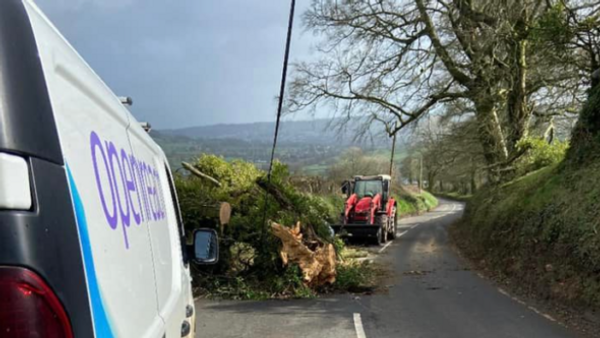Fibre to the premises (FTTP) is great until it breaks

August 2022
Ultrafast Full Fibre – better performance, impressive speeds and fewer drop-outs with fibre connected to straight to your home. Fibre optic cables, according to Openreach, are powerful and resilient, so you can always rely on being connected. But can you?
Networks need to be reliable and protected enough to deal with normal weather conditions, such as ice, snow and wind. But no matter how well a network is built, freak weather can cause damage and this can have a knock-on effect on wired and wireless communications, leaving communities isolated exactly when they need access to information.
In the space of just six days during February this year, the UK experienced three named storms – Dudley, Eunice and Franklin - that brought damage and disruption to the Openreach network.
When the high winds of Storm Eunice struck on 18th February 2022, around 200,000 homes and businesses were left without power across the south of the UK, overhead fibre optic cables were either damaged by fallen trees or pulled out entirely and over 650 poles were badly damaged and needed replacing. Some services took longer to fix than others, especially if they required road closures, specialist equipment or safety measures. Many people, including a number of RuralTech clients, were without an internet connection not just for a few days, but several weeks.
For many people, going without the internet even for a few hours is unthinkable. With extreme weather events becoming more common, it might be worth investing in an alternative broadband solution – in addition to your traditional fixed-line broadband - so that if there is an internet outage in the future, you and/or your business can carry on as normal.
Here are a few ‘backup’ options you can consider:
1. Tethering, using your phone
For light internet usage, such as reading emails, you might simply be able to use your phone’s internet connection to get online.
To do this, you can either:
-
Tether your phone to your PC, using the phone’s charging cable. You will need to plug the cable into your computer’s USB port. Then, there should be a prompt on your phone to begin tethering your internet connection.
-
Create a mobile hotspot on your phone, and connect to it using your PC. This is just like creating a small Wi-Fi network, that any of your devices can use to get online.
The disadvantage of this method is it may use up your mobile data allowance very quickly. Once you hit your monthly limit, you may face extra usage charges.
2. Mobile broadband dongles
Rather than plugging your phone into your computer, you can plug a specialised device called a dongle into one of your USB ports.
These devices have a SIM card slot, and a 4G or 5G antenna. Just like your phone, they connect to a mobile broadband network, in order to get online.
When you plug a dongle into your computer, it will prompt you to install some software drivers. It may also open a page in your web browser, and have you log in. Then, you can get online anytime you want, by plugging in the dongle.
The good thing about dongles is how easy they are to use. However, they’re only really suitable for getting online on computers – they’re not great if you want to use the internet on an iPad or Xbox for example, since these devices don’t have a USB port.
You can buy dongles with different types of data plans, depending on your needs.
3. Mobile Wi-Fi (MiFi) devices
MiFi (Mobile Wireless Fidelity) is a personal internet connection, based on cellular signal. A MiFi device is a small, portable, battery-powered wireless router that connects via Bluetooth to your laptop or computer wherever you are.
Its signal can be shared between multiple internet-enabled devices — such as smartphones, laptops, tablets and even games consoles — that are within its range. They can be used anywhere that has a mobile network connection.
Mi-Fi is not designed to be a long-term solution. It’s a lot slower than Wi-Fi and requires a SIM card and a data plan with a carrier to work.
4. Mobile broadband - 4G/5G routers
These types of devices are just like broadband routers, except they use 4G or 5G to connect to the internet, rather than your landline.
They take a SIM card and plug into the wall. Once set up, your router will create a Wi-Fi network, that you can connect your devices to. You should also be able to use an Ethernet cable to connect devices to your router.
These types of routers are typically the best option if you’re looking for a permanent alternative to fixed-line broadband. Provided you get a good 4G or 5G signal at home, you’ll be able to get good speeds, and easily connect multiple devices to the internet.
5. Satellite broadband
Just like satellite TV, satellite broadband is beamed all the way from space to a satellite dish that’s installed on your property. It then gets hooked up to a Wi-Fi router just like normal broadband.
New satellite internet technology that’s being introduced now is expected to completely replace the older, slower system that currently exists. Led by Elon Musk’s Starlink project (a division of his company, SpaceX), these new satellites use lasers instead of radio waves to work. Availability is expected to grow rapidly this decade. Starlink has already launched well over a thousand satellites into low Earth orbit and, thanks to a recently-acquired license for a satellite ground station in the Isle of Man (to add to its existing ones in Cornwall and Buckinghamshire), may soon be able to achieve ‘blanket’ internet coverage across the UK.
If your business cannot operate without the internet, talk to us today about a backup solution!


